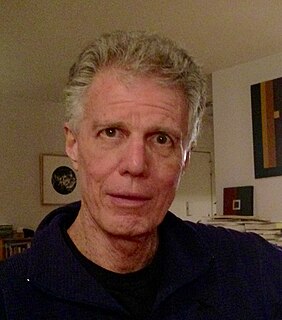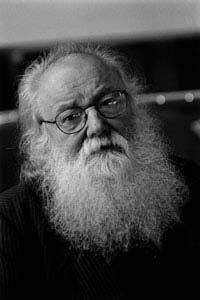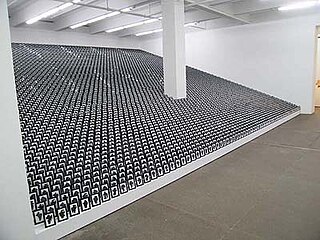Richard Milazzo is a critic, curator, publisher, independent scholar and poet from New York City. In the 1970s, he was the editor and co-publisher of Out of London Press. He is the co-founding publisher and editor of Edgewise Press. In the 1980s, under the rubric of Collins & Milazzo, he co-curated numerous Collins & Milazzo Exhibitions and co-wrote with Tricia Collins essays on art and art theory. [1]
Richard Milazzo is a graduate of McBurney School and Franklin and Marshall College. In the 1970s, he earned an M.A. for his thesis on Ezra Pound’s Cantos at City College of New York. [2] [3] [4] [5]
He is the editor of Edgewise Press, a small press art publication house founded by Milazzo [6] [7] in 1995. It maintains editorial offices in New York and Paris and is dedicated to publishing small, uniformly packaged, paperback books on art criticism, art theory, [8] aesthetics, philosophy, fiction and poetry. [9] [10]
Since 1982, he has worked internationally as a critic and curator in the art world. In the early 1980s, he co-published and co-edited Effects : Magazine for New Art Theory [11] in the East Village. [12]
Among the many publications of those years were Radical Consumption and the New Poverty (New York: New Observations, 1987); Art at the End of the Social (Malmö, Sweden: The Rooseum, 1988); and Hyperframes: A Post-Appropriation Discourse in Art, the lectures they delivered as Senior Critics at Yale University in 1988 and 1989. [13] They were reissued in an Italian edition by Campanotto Editore in Udine in 2005. In 2014 Milazzo authored the book Peter Nagy: Entertainment Erases History (Works 1982 to 2004 to the Present) for Eisbox Projects. [14]
The idea of neo-conceptual art (sometimes later termed post-conceptual art) articulated by Tricia Collins and Richard Milazzo in the early 1980s in New York City, [15] brought to prominence a new generation of artists through their copious writings and curatorial activities. It was their exhibitions and writings that originally fashioned the theoretical context for a new kind of neo (or post) conceptual art; one that argued simultaneously against Neo-Expressionism and The Pictures Generation. [16] It was through this context that the work of many of the artists associated with Neo-Conceptualism (or what some of the critics reductively called Simulationism and Neo Geo) was first brought together. [17] [18] [19] [20]

Postmodern art is a body of art movements that sought to contradict some aspects of modernism or some aspects that emerged or developed in its aftermath. In general, movements such as intermedia, installation art, conceptual art and multimedia, particularly involving video are described as postmodern.

Robert C. Morgan is an American art critic, art historian, curator, poet, and artist.

Pierre Restany, was an internationally known French art critic and cultural philosopher.

Joseph Nechvatal is an American post-conceptual digital artist and art theoretician who creates computer-assisted paintings and computer animations, often using custom-created computer viruses.
Peter Halley is an American artist and a central figure in the Neo-Conceptualist movement of the 1980s. Known for his Day-Glo geometric paintings, Halley is also a writer, the former publisher of index Magazine, and a teacher; he served as director of graduate studies in painting and printmaking at the Yale University School of Art from 2002 to 2011. Halley lives and works in New York City.

Neo-conceptual art describes art practices in the 1980s and particularly 1990s to date that derive from the conceptual art movement of the 1960s and 1970s. These subsequent initiatives have included the Moscow Conceptualists, United States neo-conceptualists such as Sherrie Levine and the Young British Artists, notably Damien Hirst and Tracey Emin in the United Kingdom, where there is also a Stuckism counter-movement and criticism from the 1970s conceptual art group Art and Language.

Jonathan Lasker is an American abstract painter whose work has played an integral role in the development of Postmodern Painting. He currently lives and works in New York City.
Saint Clair Cemin is a postmodern sculptor.
Neo-minimalism is an amorphous art movement of the late 20th and early 21st centuries. It has alternatively been called Neo-Geometric or "Neo-Geo" art. Other terms include: Neo-Conceptualism, Neo-Futurism, Neo-Op, Neo-pop, New Abstraction, Poptometry, Post-Abstractionism, and Smart Art.

Robert Carleton Hobbs is an art historian and curator specializing in twentieth-century art. Since 1991 he has held the Rhoda Thalhimer Endowed Chair of American Art in the School of Arts, Virginia Commonwealth University, a highly ranked art department. Since 2004 he has served as a visiting professor at Yale University. He has held positions at Cornell University, University of Iowa, Florida State University, and Tehran Museum of Contemporary Art in Iran, and is known for a number of books, in-depth essays, and exhibitions.
Peter Nagy is an American artist and gallerist. Nagy is the owner of Gallery Nature Morte, founded in New York City and now located in India.
Steven Parrino (1958–2005) was an American artist and musician associated with energetic punk nihilism. He is best known for creating big modernist monochrome paintings that he violently slashed, torn or twisted off their stretchers. He died in a motorcycle traffic accident in Greenpoint, Brooklyn at the age of 46.
James Allan Curtis, known professionally as Diego Cortez, was an American filmmaker and art curator closely associated with the no wave period in New York City. Cortez was the co-founder of the Mudd Club, and he curated the influential post-punk art show New York/New Wave, which brought the then aspiring artist Jean-Michel Basquiat to fame.
Post-conceptual, postconceptual, post-conceptualism or postconceptualism is an art theory that builds upon the legacy of conceptual art in contemporary art, where the concept(s) or idea(s) involved in the work takes some precedence over traditional aesthetic and material concerns. The term first came into art school parlance through the influence of John Baldessari at the California Institute of the Arts in the early 1970s. The writer Eldritch Priest, specifically ties John Baldessari's piece Throwing four balls in the air to get a square from 1973 (in which the artist attempted to do just that, photographing the results, and eventually selecting the best out of 36 tries as an early example of post-conceptual art. It is now often connected to generative art and digital art production.
Tricia Collins is an American art critic, art gallerist and curator of contemporary art. She was half of the curatorial team Collins & Milazzo, with Richard Milazzo, who together co-published and co-edited Effects : Magazine for New Art Theory from 1982 to 1984. She later ran the art galleries Grand Salon, Tricia Collins Grand Salon, and Tricia Collins Contemporary Art in New York City until the year 2000.
Stux Gallery is a contemporary fine art dealership located on 520 West End Avenue on the Upper West Side of Manhattan, New York City. Artists represented/exhibited by the gallery have included Doug and Mike Starn, Vik Muniz, Andres Serrano, Dennis Oppenheim, Elaine Sturtevant, Inka Essenhigh, and Orlan.
Kevin Larmon is an American artist and was assistant monitor of painting at Syracuse University.
The Collins & Milazzo exhibitions were a series of art exhibitions curated by the team Tricia Collins and Richard Milazzo, mainly in New York in the mid-1980s to early 1990s.
Effects: Magazine for New Art Theory was an American arts magazine. It was co-published and co-edited by Tricia Collins and Richard Milazzo from 1983 to 1986 in New York City. All issues were offset-printed staple bound 27.7 x 21.3 cm.
Neo-geo or Neo-Geometric Conceptualism was an art movement from the 1980s that utilizes geometric abstraction and criticizes the industrialism and consumerism of modern society. The usage of the term neo-geo began when it was first used in reference to a 1986 exhibition at the Sonnabend Gallery in SoHo that included the artwork of Ashley Bickerton, Jeff Koons, Peter Halley and Meyer Vaisman. According to artist Michael Young, Neo-geo artwork recognizes technology as both a promise and a threat.